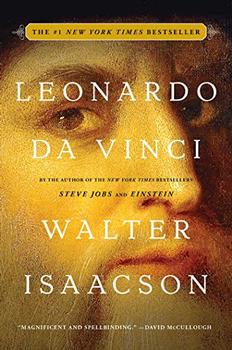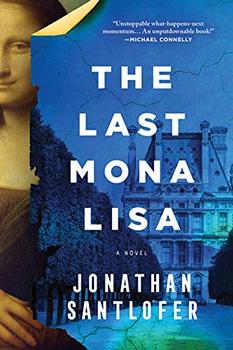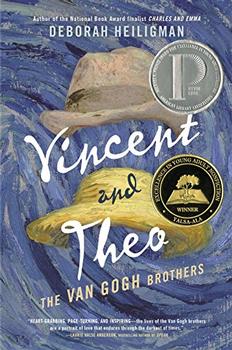Summary | Excerpt | Reviews | Beyond the book | Read-Alikes | Genres & Themes | Author Bio

Critics' Opinion:
Readers' Opinion:
First Published:
Oct 2017, 624 pages
Paperback:
Oct 2018, 576 pages
 Book Reviewed by:
Book Reviewed by:
Rose Rankin
Buy This Book
The name Leonardo da Vinci is one of the most recognized in all of Western history, and his paintings are some of the most beloved works of the Renaissance. In November 2017, Salvator Mundi, which still has experts disagreeing over whether Leonardo actually painted it, sold for a record-breaking $450 million. When tackling such a well-known figure, it takes both skill and creativity to share new insights with readers. Thanks to his innovative use of source materials, Walter Isaacson has done just that in his latest biography, Leonardo da Vinci.
Isaacson quickly sketches Leonardo's early life as the illegitimate son of a middle-class notary. Rather than be shunned because of his status, Leonardo, born in 1452, grew up surrounded by family, seemingly untroubled by his being a bit of an outsider who showed artistic talent at an early age. In reconstructing his life story beyond childhood, Isaacson relies primarily on Leonardo's own notebooks, of which over 7,000 pages still exist today. This allows us readers to see the inner workings of his mind and imagination as his life took him from a tiny Tuscan village to the epicenters of the Renaissance. (See Beyond the Book)
Around 1464 Leonardo moved to Florence, where he became an apprentice in an art and engineering workshop run by a minor artist, Andrea del Verrocchio. He would stay in Florence nearly 15 years before relocating to Milan to live and work at the court of Duke Ludovico Sforza. The constantly shifting nature of Italian politics caused Leonardo to move frequently throughout his life, as the fortunes of his patrons waxed and waned.
As his story unfolds, Isaacson pauses throughout to delve into the many aspects of Leonardo's genius: designing war machines, studying fluid dynamics, exploring flight, performing dissections and anatomical studies, and of course, painting, to name only a few of Leonardo's obsessions. By using the notebooks as the primary source material, Isaacson shows us doodles and flights of fancy as well as detailed diagrams and planned sketches. He describes the entries in detail, and reprints images directly from them.
We see how Leonardo's study of light and optics resulted in the chiaroscuro, or shadowy contrasts, that make his paintings so realistic. We learn how his diligent exploration of facial and lip muscles helped him to paint the most subtle yet memorable smile in history in the Mona Lisa. Isaacson explains, "…his analysis of nature informed his art, which informed his analysis of nature." And indeed, his notebooks reveal a mind of boundless curiosity and singular brilliance.
We also learn just how much of Leonardo's genius stayed in his notebooks and never reached his contemporaries. From principles of motion to innovative sewers, Leonardo was far ahead of his time. His theorizing and experimentation preceded the scientific method of the Enlightenment, and his discovery of how heart valves function wouldn't be properly understood by doctors until the 1960s.
And yet, so much was left undone—countless discoveries went unpublished, his flying machines and fearsome weapons were left unbuilt, and numerous unfinished paintings were never given to those who commissioned them. Isaacson, however, reinterprets these events with a twist: rather than bemoan what didn't happen, he opines that Leonardo was happier by moving from subject to subject, that he enriched his own life by following his changing passions.
It's hard to argue with this interpretation. The Leonardo who comes through in this account is a friendly and approachable genius. He appears comfortable with his homosexuality, unlike his contemporary Michelangelo. He's surrounded by students, assistants, and friends throughout his life—the very opposite of the brooding loner trope so often applied to artists.
Isaacson does Leonardo a great service by humanizing him, and he clearly admires his subject's genius, which was all the more impressive since Leonardo had very little formal education. However the author sprinkles references to modern geniuses throughout and particularly in his didactic conclusion telling readers to be like Leonardo. Steve Jobs was undoubtedly a genius in his own right, but comparing men who lived almost 500 years apart is ahistorical since their times are so different, and too often it feels like Isaacson is plugging his earlier books.
These stumbles aside, the biography provides a rich and fascinating look inside one of the world's greatest minds, from his to-do lists to his masterpieces. It inspires wonder at what one person can do, and appreciation for all that this true Renaissance man accomplished.
![]() This review was originally published in The BookBrowse Review in January 2018, and has been updated for the
October 2018 edition.
Click here to go to this issue.
This review was originally published in The BookBrowse Review in January 2018, and has been updated for the
October 2018 edition.
Click here to go to this issue.

If you liked Leonardo da Vinci, try these:

by Jonathan Santlofer
Published 2021
A gripping novel exploring the Mona Lisa's very real theft in 1911 and the present underbelly of the art world, The Last Mona Lisa is a suspenseful tale, tapping into our universal fascination with da Vinci's enigma, why people are driven to possess certain works of art, and our fascination with the authentic and the fake.

by Deborah Heiligman
Published 2019
From the author of National Book Award finalist Charles and Emma comes an incredible story of brotherly love.





The House on Biscayne Bay
by Chanel Cleeton
As death stalks a gothic mansion in Miami, the lives of two women intertwine as the past and present collide.

The Flower Sisters
by Michelle Collins Anderson
From the new Fannie Flagg of the Ozarks, a richly-woven story of family, forgiveness, and reinvention.

The Funeral Cryer by Wenyan Lu
Debut novelist Wenyan Lu brings us this witty yet profound story about one woman's midlife reawakening in contemporary rural China.
Your guide toexceptional books
BookBrowse seeks out and recommends the best in contemporary fiction and nonfiction—books that not only engage and entertain but also deepen our understanding of ourselves and the world around us.